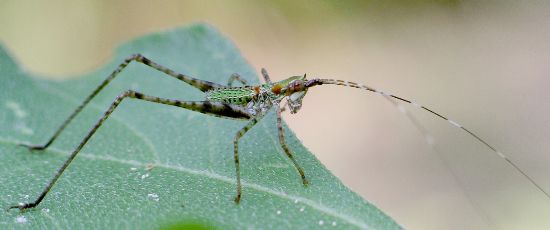by Valerie
February, 2007Fork-tailed Bush Katydid
Our featured beast this month is a type of long-horned grasshopper, or katydid. The fork-tailed bush katydid (Scudderia furcata) is actually a false katydid. There are more false than true katydid species and the two groups are differentiated by several features, including whether or not the tympanums are exposed in their ears, which are located on the front legs. In true katydids, they are hidden within slits. Katydids are generally large and green, resembling leaves, and have very long antennae. The individual pictured above is a very young nymph, most likely a second instar (out of five or six such stages between hatching and adulthood, a growth pattern known as simple, or gradual, metamorphosis). At this young age, the tiny insect has no wings and isn't all that green. The striped antennae are quite distinctive, though. These nymphs are frequently found on flowers, as they like to feed on the pollen and other tender and tasty bits of the plants. Even adult katydids eat flowers, but they also tend to munch leaves and stems as well. Katydids are often active during the day, quietly feeding on plants while their green camouflage coloring protects them from predators. Mating usually takes place at night, and the loud, familiar calls of various katydid species are heard from dusk to dawn during the warm months. Males do much of the calling, but sometimes the females answer with a softer sound. In the morning, it is not uncommon to find females with large, white, jelly-like globs hanging just below their ovipositors (the egg-laying structures that stick out their back ends). These are called spermatophores, attached and hanging outside of the female bodies, and they are a combination of sperm packages that the males insert into the females and nutritious "jelly" called spermatophylax. The males are in this way making an expensive contribution to their future offspring, as the females eat the jelly and absorb the nutrients while their eggs develop. Eggs are usually laid in a row on plant stems. |